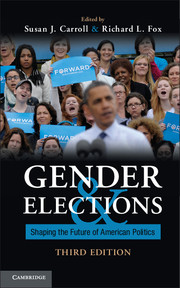Book contents
- Frontmatter
- Contents
- List of Figures, Text Boxes, and Photos
- List of Tables
- Contributors
- Acknowledgments
- Introduction
- 1 Presidential Elections
- 2 Cracking the “Highest, Hardest Glass Ceiling”
- 3 Voter Participation and Turnout
- 4 Voting Choices
- 5 Latinas and Electoral Politics
- 6 African-American Women and Electoral Politics
- 7 Congressional Elections
- 8 Political Parties and Women's Organizations
- 9 Advertising, Websites, and Media Coverage
- 10 Women's Election to Office in the Fifty States
- Index
- References
3 - Voter Participation and Turnout
The Political Generational Divide among Women Voters
Published online by Cambridge University Press: 05 June 2014
- Frontmatter
- Contents
- List of Figures, Text Boxes, and Photos
- List of Tables
- Contributors
- Acknowledgments
- Introduction
- 1 Presidential Elections
- 2 Cracking the “Highest, Hardest Glass Ceiling”
- 3 Voter Participation and Turnout
- 4 Voting Choices
- 5 Latinas and Electoral Politics
- 6 African-American Women and Electoral Politics
- 7 Congressional Elections
- 8 Political Parties and Women's Organizations
- 9 Advertising, Websites, and Media Coverage
- 10 Women's Election to Office in the Fifty States
- Index
- References
Summary
You've come a long way, baby. A century ago, your mothers, grandmothers and great-grandmothers…and most of their sisters across the land of the free and the home of the brave were still eight years from the right to vote [1920]. This year, the presidential [election] not only involves you, ladies, it's all about you. Both parties will spend millions courting you because whoever wins your favor likely wins…the election.
Bob Lewis, Associated Press June 24, 2012As the 2012 general election gets under way, analysts have posited that young, secular women are likely to be the most coveted swing group. The degree to which the Obama campaign can win them over may well be the single most pivotal factor in the campaign.…[A]s Romney seeks to make inroads, he may need to find a new way of reaching women voters.
Molly Ball, The Atlantic April 2012Women make up majorities of the U.S. voting-age population, registered voters, and actual voters. These facts explain why both major political parties – Democratic and Republican – and women's advocacy groups from across the ideological spectrum worked hard to mobilize women voters in 2012.
- Type
- Chapter
- Information
- Gender and ElectionsShaping the Future of American Politics, pp. 80 - 118Publisher: Cambridge University PressPrint publication year: 2013



